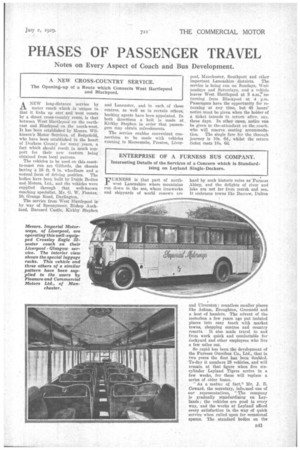ENTERPRISE OF A FURNESS BUS COMPANY.
Page 67

Page 68

If you've noticed an error in this article please click here to report it so we can fix it.
Interesting Details of the Services of a Concern which is Standardizing on Leyland Single-Deckers.
FURNESS is flat part of northwest Lancashire where mountains run down to the 'sea, where ironworks and shipyards of world renown are
hard by such historic ruins asTurness Abbey, and the, delights of river and lake are not for from marsh and sea. It embraces towns like Barrow, Dalton and Ulverston : countless smaller places like Askam Broughton, Greenodd and a host of hamlets. The advent of the motorbus a few years ago put isolated places into easy touch with market towns, shopping centres and country resorts. It also made travel to and from work quick and comfortable for dockyard and other employees who live a few miles out.
So rapid has been the development of the Furness Omnibus Co.. Ltd.' that in two years the fleet has been doubled. To-day it numbers 28 vehicles, and will remain at that figure when five sixcylinder Leyland Tigers arrive in a few weeks, for these will replace a series of older buses.
"As a matter of fact,'-' Mr. J. E. Coward, the secretary, informed one of our representatives, "The company is gradually standardizing on Leylands ; the vehicles are good in every way, and the works at Leyland afford every satisfaction in the way of quick service when called upon for occasional spares. The standard bodies on the Leylands have left little or no room for criticism?'
Practically all the vehicles. are (or will be) 31 to 35-seaters, and all are single-deckers, because the local circumstances are against the adoption of double-deckers. For example, there is no promenade traffic to cater for, whilst it will be understood that, on account of the geographical location of Furness, with the Irish Sea on the west, Morecambe Bay on the south, and the Lakeland mountains inland, wild, windy spells of weather are often met. Furthermore, no short local point-topoint journeys are run in any town. All journeys cover at least a few miles of town and country combined. The merits of double-deckers for use in some .places are not disputed, but it is
simply a case of thei; aot being deemed, best for Furness traffic.
The Furness Omnibus Co., Ztd., has, during the past few months. incorporated the Lansdale Pullman Co. and the Barrow Bus Co., and during the recent Gereral Election an interesting item of amusement evolved from this three-in-one position. Each concern had a different colour of bus, of course, when operating separately, and the result was that supporters of red, blue or yellow in politics were humorously selecting their favourite colour when travelling — the results, nevertheless, going into one company's coffers !
The development during two years of the Furness Omnibus Co., Ltd., is evidenced by the fact that the number of route miles traversed by its vehicles has increased from 16 to 66. The headquarters, the main office and central garage are at Beck Side Road, Daltonin-Furness; whilst branch garages are located at Newlands (Ulverston) and at Lindal-in-Furness.. From the headquarters the routes served include Barrow, Broughton, Illverston, Windermere and Ambleside.
Those who remember the modest B42 inauguration of the concern about five years ago will realize vividly the fears and wonders and anxieties of interested friends. The result is a veritable triumph for the Motorbus per se, and •
for the organizers. Thew. pioneers bad not merely to cater for a demand, but largely to create it, by demonstrating to the public the benefits of travelling by modern passenger-motor vehicles.




















































































































